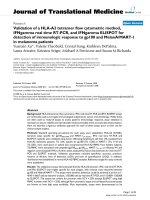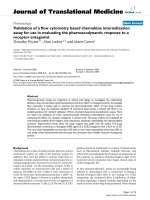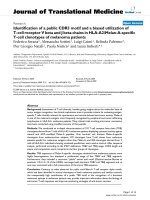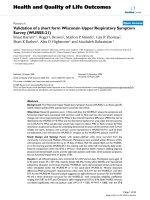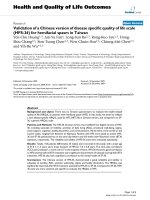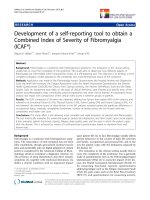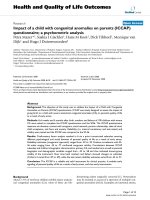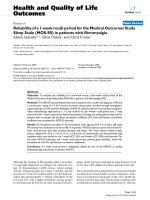Báo cáo hóa học: " Design of a series visco-elastic actuator for multi-purpose rehabilitation haptic device" pptx
Bạn đang xem bản rút gọn của tài liệu. Xem và tải ngay bản đầy đủ của tài liệu tại đây (1.55 MB, 14 trang )
JNER
JOURNAL OF NEUROENGINEERING
AND REHABILITATION
Design of a series visco-elastic actuator for
multi-purpose rehabilitation haptic device
Oblak and Matjačić
Oblak and Matjačić Journal of NeuroEngineering and Rehabilitation 2011, 8:3
(20 January 2011)
METH O D O LOG Y Open Access
Design of a series visco-elastic actuator for
multi-purpose rehabilitation haptic device
Jakob Oblak
*
, Zlatko Matjačić
Abstract
Background: Variable structure parallel mechanisms, actuated with low-cost motors with serially added elasticity
(series elastic actuator - SEA), has considerable potential in rehabilitation robotics. However, reflected masses of a
SEA and variable structure parallel mechanism linked with a compliant actuator result in a potentially unstable
coupled mechanical oscillator, which has not been addressed in previous studies.
Methods: The aim of this paper was to investigate through simulation, experimentation and theoretical analysis
the necessary conditions that guarantee stability and passivity of a haptic device (based on a variable structure
parallel mechanism driven by SEA actuators) when in contact with a human. We have analyzed an equivalent
mechanical system where a dissipative element, a mechanical damper was placed in parallel to a spring in SEA.
Results: The theoretical analysis yielded necessary conditions relating the damping coefficient, spring stiffness,
both refl ected masses, controller’s gain and desired virtual impedance that needs to be fulfilled in order to obtain
stable and passive behavior of the device when in contact with a human. The validity of the derived passivity
conditions were confirmed in simulations and experimentally.
Conclusions: These results show that by properly designing variable structure parallel mechanisms actuated with
SEA, versatile and affordable rehabilitation robotic devices can be conceived, which may facilitate their wide spread
use in clinical and home environments.
Background
Rehabilitation r obotics is a rapidly evolving field [1-4].
Numerous haptic robots were developed for movement
training of upper extremities following neurologica l dis-
order. According to works published to date, robots for
upper extremity motor rehabilitation are usually serial
linkage mechanisms that can be in general divided in
two groups. The first consists of serial linkage mechan-
isms with only 1 t o 3 degrees of freedom (DOF), where
the end-effector of the robot is in contact with the
user’s hand, making it suitable for only one activity of
upper extremity movement (either arm reaching move-
ment or wrist movements). Clinical use of such low-
DOF serial mechanisms [5-10] necessitates the use of
two or more devices in order to provide comprehensive
upper extremity movement training. This is neither con-
venient from a practical nor cost-effective point of view.
On the other hand, exoskeleton mechanisms may have
up to 7 DOF [11-13] and can provide comprehensive
upper extremity movement rehabilitation. However,
such mechanisms require high quality back drivable
actuators for each DOF, which necessitates co mplex and
thus expensive design.
Few rehabilitation robots have implemented a parallel
kinematic s tructure. Parallel mechanisms usually have
mechanical linkages with many DOF that greatly exceed
the resulting DOF of the whole mechanism. This prop-
erty allows for a design where some of the joints may be
easily locked or unlocked, thus resulting in different
workspace configurations suitable for different aspects
of arm or wrist movements training. Another character-
istic of parallel robots is that the actuators are located at
the robot’s base. This feature allows the implementation
of series elastic actuators (SEA) [14-16] that uti lize stan-
dard off-the-shelf DC motors with suitable planetary
gearheads and suitable springs, providi ng simi lar overall
haptic performance as their high quality back-drivable
counterparts. Universal Haptic Drive (UHD) [17] and
Variable Structure Pantograph (VSP) [18] are t he two
* Correspondence:
University Rehabilitation Institute, Republic of Slovenia, Linhartova 51, 1000
Ljubljana, Slovenia
Oblak and Matjačić Journal of NeuroEngineering and Rehabilitation 2011, 8:3
/>JNER
JOURNAL OF NEUROENGINEERING
AND REHABILITATION
© 2011 Oblak and Matjač čćć; licensee BioMed Central Ltd. This is an Open Access article distributed under the terms of the Creative
Commons Attribution License (http ://creativecommons.org /licenses/by/2.0), which permits unrestricted use, distributio n, and
reprodu ction in any medium, provided the original work is properly cited.
devices in which mechanisms with lockable joints and
SEA actuation were successfully implemented and tested
in clinical practice.
However, from a contro l point of view, both beneficial
aspects; parallel kinematic structure (such as VSP) and
SEA based drive, result in a mechanical system where
the reflected masses of the SEA and the parallel kine-
matic structure (serially connected with a spring)
become comparable, resulting in a coupled mechanical
oscillator. Suitable control of such a rehabilitation robot,
which should provide stable haptic interaction when in
contact with a human, may present a considerable chal-
lenge, not addressed in previous studies.
The aim of this paper was to investigate theoretically,
through s imulations and experimentally the necessary
conditions that guarantee stability and passivity of a
haptic device, based on a variable structure parallel
mechanism driven by SEA actuators, when in contact
with a human. We have analyzed an equivalent mechan-
ical system where a dissipative element, a mechanical
damper, was placed in parallel with a spring in SEA.
The goal was to derive conditions that must be met in
order to allow use of a SEA driven variable structure
parallel mechanism as a stable haptic interface in upper
extremity rehabilitation.
Methods
Variable structure pantograph: mechanical linkage
Figure 1 shows a VSP haptic device that is composed of
a variable structure parallel linkage and two SEA actua-
tors. A brief description on the device is provided here,
while more detailed information can be found in [17,18].
The main parts of the parallel mechanism are the three
joints that can be either locked or released (Figure 2(A)).
By locking or releasing DOFs in these joints (I, II, III),
the mechanical configuration of VSP can be changed,
enabling use of the device in several operational modes
shown in Figure 2. The three possible modes (“ARM” ,
“WRIST” and “REACH”) are briefly described below.
“ARM” mode: locking joint I and releasing joints II
and III, results in 2 DOF quasi-planar movements in
Forward/Backward/Left/Right directions, as shown in
Figure 2(B). The movement prescribed by the workspace
“ARM” mode is similar to required for reaching and/or
moving objects on a table, desk, or countertop.
“WRIST” mode: the mechanical configura tion, termed
as “WRIST” mode, is achieved by relea sing joint I and
locking joints II and III. A subject holding on the handle
bar can perform movements in wrist as shown in Figure
2(C). By setting the offset orientation of the handle bar
in the horizontal or vertical position, movement of all 3-
DOFs in wrist (Flexion/Extension, Radial/Ulnar devia-
tion and Pronation/Supi nation as shown in Figure 2(C))
can be achieved. The resulting moveme nt of the user’s
wrist is similar to what is required for performing wrist-
orienting motions in the following activities: pouring
from a bottle, brushing teeth, or stirring a pot.
“REACH” mode: locking joints I and III and releasing
joint II results in a mechanical configuration, which
allows training of Forward and Up/Lateral reach move-
ments.Thesemotionsaretherefore similar to activities
such as reaching for a high drawer or cupboard, or mov-
ing objects from one side of the cupboard to the other.
Variable structure pantograph: series visco-elastic
actuation
The variable structure parallel linkage of VSP is actuated
by a SEA based drive as shown in Figure 1. The imple-
mented drive consists of two sets of DC motors
(Maxon, RE40, 150 W) with gearheads (GP 52 C, 81:1)
and incremental encoders. Torques from both gear-
heads’ shafts impose force on the actuated bar through
serially added mechanical springs and string wires, see
Figure 3(A, B). The string wires are connected t o the
actuated bar perpendicular one to another, which
enables actuation of the VSP in 2DOFs.
Introduction of an elastic element (mechanical spring) in
series with t he motor provides many benefits, including:
more accurate and stable force control, attenuation o f both
backl ash and friction nonlinear effects and the actuat ors’
own impedance as well as providing greater shock tolerance
(important for safety concerns). On the other hand, intro-
ducing SEA in haptic drive lead s to reduction of the achiev-
able force bandwidth. Since relatively slow movements can
be expected dur ing rehabilitation train ing, reduced force
bandwidth does not present a significant problem.
Utilization of a variable structure parallel mec hani sm
is essential in designing a versat ile rehabilitation device.
However, using a parallel m echanism where consider-
able endpoint mass is in series with both SEA ’sspring
and motor mass, results in a coupled oscillator needing
appropriate damping. Adequate dissipation of mechani-
cal energy is needed, to achieve a stable haptic interac-
tion when the devic e is in contact with a human. A
convenient location for a mechanical damper may be in
parallel with the SEA spring. Figure 3(A, B) presents a
schematic illustration of an implemented parallel
mechanism driven by a series visco-elastic actuator.
Variable structure pantograph: linearized model
In Figure 4, the open loop model is illustrated, where M
and m denotes masses, X
I
and X
o
positions, and F
I
and
F
O
forces on the motor and the actuated bar, respectively.
Attaching parallel mechanism on the actuated bar, signif-
icantly increases endpoint mass. The motor is coupled to
theparallelmechanismviaamechanicalspringKand
damper b. The equivalent viscous friction in the motor
and planetary gearhead is marked with B [17].
Oblak and Matjačić Journal of NeuroEngineering and Rehabilitation 2011, 8:3
/>Page 2 of 13
Figure 1 The photograph of variable structure pantograph (VSP). The essence of the VSP is variable structure parallel mechanism, which is
driven by a visco-elastic actuator. The VSP promises high suitability for training of upper extremity tasks involving hand positioning and
orientation.
Oblak and Matjačić Journal of NeuroEngineering and Rehabilitation 2011, 8:3
/>Page 3 of 13
The relation between motor mass and the mass of the
parallel mechanism can be given by two differential
equations:
F -MX BX KX KX bX bX 0
II I I O I O
−−+ −+ =
(1)
KX KX bX bX mX F
IOIO OO
−+−− −=
0.
(2)
By taking Laplace transforms and relating equations,
an expression relating F
O
,X
O
and F
I
can be found:
F
Ms B b s K ms bs K bs K
Ms B b s K
O
=−
++−
+
⎛
⎝
⎜
⎜
⎞
⎠
⎟
⎟
(( (
((
22 2
2
+)+)( +) +)
+)+)
XX
bs K
Ms B b s K
F
O
I
+
+
++ +
⎛
⎝
⎜
⎜
⎞
⎠
⎟
⎟
()
(())
2
(3)
This equation is important, for it determines the
motor torque/force F
I
, needed to achieve a given output
force F
O
, when the handle bar of the VSP is moving. If
the parallel mechanism of the device is assumed to be
clamped
X
O
=
()
0
, then the transfer function between
output force and motor force is:
F
F
bs K
Ms B b s K
O
I
2
=
+
++ +()
(4)
On the other hand, the position to force transfer func-
tion of the uncontrolled plant (F
I
= 0) is defined as:
F
X
Ms B b s K ms bs K bs K
Ms B b s K
O
O
−
=
++−
+
(( (
((
22 2
2
+)+)( +) +)
+)+)
(5)
ThenegativesignbeforeX
O
comes from the defini-
tion of the directions of F
O
and X
O
.Thesetwoequa-
tions define the model of the plant to be controlled.
The motion of the handle bar (X
O
) is modelled as a dis-
turbance on the output force (F
O
), see shaded block in
Figure 5.
The principal purpose of haptic devices is to allow
human operators to touch, feel and manipulate objects
in a virtual environment. For this reason, the impedance
felt at the handle bar should be as close as possible to
the desired virtual impedance (V, Figure 5).
Usually, three cri teria are employed when designing
haptic devices [19]: (1) movement in free space (LOW
impedance) should be opposed with minimal possible
force, (2) solid virtual objects (HIGH impedance) must
feel stiff, and (3) virtual constraints must not be easily
saturated, which requires a suitable impedance- based
force control. In series elastic actuators, a variety of con-
trol strategies are possible. Williamson [20] proposed a
Figure 2 A variable s tructure parallel mechanism. A variable
structure parallel mechanism enables using the device in different
operational modes. Switching between modes can be easily
achieved by locking or releasing joints I, II, III (A). Workspace in the
“ARM” mode (B), “WRIST” mode (C) and “REACH” mode (D) are
presented.
Oblak and Matjačić Journal of NeuroEngineering and Rehabilitation 2011, 8:3
/>Page 4 of 13
control strategy for SEA with a feed-forward model and
PID controller. Vallery [21] chose the con cept of c as-
cade force control with proportional-integral controller.
We decided to implement the simplest approach, which
is a proportional controller, in order to have a clearer
picture on the influence of various mechanical compo-
nents on passivity of haptic interaction [22,23].
Impedance based force control (Figure 5), was imple-
mented in MATLAB (Simulink). In computer simulation,
the VSP’s haptic performance was investigated by simu-
lating sinusoidal movements of the handle bar (X
O
). In
simulation, LOW and HIGH impedance virtual force F
V
was compared to calculated force on the handle bar F
O
,
for different values of damper b and proportional gain P.
Figure 3 Series visco-elastic actuator and parallel mechanism. (A) Actuation of the VSP consists of: 1-two sets of DC motors with gears and
encoders, 2-elastic springs, 3- mechanical dampers, 4-pulleys and 5-an actuated bar. Schematic presentation of the series visco-elastic actuator
and parallel mechanism (only 1 DOF is shown for clarity), with characteristic values of mechanical component parameters used in the VSP.
Impedance felt at the arm is 16 times smaller than at the bottom of the actuated bar, because the actuated bar is divided by a spherical joint in
ratio 4:1.
Oblak and Matjačić Journal of NeuroEngineering and Rehabilitation 2011, 8:3
/>Page 5 of 13
In order to investigate the option of using low-cost
motors with potentially redundant backlash, different
values of backlash were considered in the simulation
model.
Conditions regarding stability and passivity of the system
For a haptic system, the output impedance is usually
def ined as t he transfer functio n from the velocity of the
gripper, in our case handle bar
(X
O
)
, to the opposing
force (F
O
):
Zs
F
Xs
O
O
() .=
−
(6)
Colgate [24] and Hogan [25] have proven that a sys-
tem will be stable while in contact with changing envir-
onments if and only if the output impedance Z(s), obeys
the following rules:
1. Z(s) has no poles in the right half plane
2. Re(Z(jw)) is nonnegative for all frequencies w
If these conditions are met, the impedance is a stable
function of frequency and the system exhibits passivity.
By means of E quation 6 and simplified system model
in Figure 5, output impedance of our controlled system
is given by:
Zs
F
Xs
Ms BbsKms bsK bsK VbsKP
Ms
O
O
()
( ())( )()()
(
=
−
=
++ + ++− + + +
+
22 2
2
(())( )BbsK bsKPs++++
()
⎛
⎝
⎜
⎜
⎜
⎞
⎠
⎟
⎟
⎟
(7)
First, we will check the condition of asymptotic stabi-
lity. The characteristic equation for output impedance
can be written as:
Ms B b b Ps K K Ps
32
0+++
()
++
()
=
(8)
It is obvious that Hurwitz determinants of the charac-
teristic equation for Z(s) are nonnegative for all techni-
cally realizable values of mechanical components.
Henceforth, Z(s) has no poles in right half plane and the
first rule is met.
By replacing the complex variable “s” in Equation 7 by
“jw”, the frequency response Z(jw) can be obtained. The
real part of the impedance frequency response is given by:
Re ( ) Re
()(
Zjw
F
Xjw
zzwzw
bBbPw KKPM
O
O
()
=
−
⎛
⎝
⎜
⎞
⎠
⎟
=
++
++
()
++ −
02 4
24
2
ww
22
)
⎛
⎝
⎜
⎜
⎞
⎠
⎟
⎟
(9)
Re(Z(jw)) is nonnegative for all frequencies w, if all
values z0, z2 and z4 are nonnegative (see Figure 6). This
gives three conservative conditions for the passivity of
the system that have to be considered.
First, the virtual stiffness V is limited by the stiffness of
the mechanical spring K and controller’s proportional
gain P. However, if we look at the third condition, P is
limited by the reflected motor mass M and reflected
Figure 4 A linearized model. The motor with a gearhead
(reflected mass M) is connected to the variable structure parallel
mechanism (reflected mass m) via a spring (compliance K) and a
viscous damper (damping B).
Figure 5 Impedance based force control. The inner force loop compares desired the virtual force F
V
with the force feedback F
O
. The output
impedance loop calculates the desired virtual force F
V
from the position of the handle bar X
O
.V is the desired virtual stiffness and P the
proportional gain of the controller.
Oblak and Matjačić Journal of NeuroEngineering and Rehabilitation 2011, 8:3
/>Page 6 of 13
mass of the parallel mec hanism m. It is strai ghtforward,
that value P can be increased by reducing m. The second
condition demands that there must be sufficient damping
between the relative position of mot or X
I
and parallel
mechanism X
O
. Usually, in technical realization of the
system , damping is alwa ys present due t o viscous friction
in mechanical components but is not sufficient. For this
reason, an additio nal damping e lement should be
inserted in parallel with the spring to satisfy the damping
condition for passivity of the system. The derived conser-
vative conditions for passivity are general. In the follow-
ing section, these condi tions wil l be applied to
characteristic values of the mechanical components used
in technical realization of the VSP (listed in Figure 3(B)).
Results
Variable structure pantograph: application of derived
passivity conditions
In the “ARM” and “ REACH” mode of the VSP, esti-
mated reflected mass of the parallel mechanism is rela-
tively high (m = 18 kg). From the third condition on
passivity, achievable controller’s proportional gain is
relatively small
()P
M
m
1.9≤≅
.Thisisduetothehigh
reflected mass of the parallel mechanism m. From the
first condition, maximal virtual stiffness V can be deter-
mined as
VK
P1
P
12000 N m≤≅
+
.Finally,from
the second condition, damping of
b
B M P V B M P V 4 B K P m B BP
2B B P
800 N s m
222
≥
−
≅
−+ + − +
+
() ()
()
/
is needed, if we set virtual stiffness as V = 12000 N/m
(solid virtual objects). On the other hand, if we want to
emulate free space, where V=0N/mand all the other
parameters remain the same, a much smaller damping
of b ≅ 250 Ns/m satisfies the second condition for
passivity.
In the “ WR IST” mode, parameters needed to meet
conditions of passivity are different. Given that almost
all mass of the parallel mechanism is supported by joints
IIandIIIandthereforedoesnotmove(seeFigure2)
and that only the segment w ith the handle bar is mov-
ing, the reflected mass is much smaller (m = 10 kg). For
this r eason values that satisfy conditions of passivity in
the “WRIST” mode are different; see Table 1.
It is obvious from Figure 6 that it is more demanding
to meet conditions of passivity in the case where the
end point mass (reflected mass of parallel mechani sm
m) is higher. For this reason, in further analysi s higher
mass of parallel mechanism ( m = 18 kg in the “ARM”
and “REACH” modes) was considered.
Results listed in Table 1 present conservative condi-
tions for passivity of the VSP, where all v alues z0, z2,
and z4 are nonnegative. However, Re(Z(jw)) can be non-
negative for all frequencies w and desired V, also with
suitable selection of P and b (see Figure 7). The maxi-
mal achievable virtual stiffness V in a HIGH impedance
environment is 12000 N/m, which is sufficient for
rehabilitation purposes. As can be seen from Figure 7,
passive VSP behavior in any mode can be achieved (Re
(Z(jw)) ≥ 0), if P ≤ 19 an d parallel damping is at least
b ≥ 780 Ns/m.
When considering technical realization, a parallel
damper with damping coefficient of b ≥ 780 Ns/m
would be a rather heavy duty mechanical e lement. For
this reason, it was decided to set b ≈ 200 Ns/m, which
can be techn ically realized, h owever at the expense of
reduced controller’s proportional gain P. By demanding
VSP’ passivity in a HIGH impedance virtu al environ-
ment (V = 12000 N/m) where parallel damping is b =
200 Nm/s, P should not exceed a value of 0.95 (see
Figure 8(A)). By reducing the virtual stiffness V, propor-
tional gain P can be increased (Figure 8(B), while main-
taining VSP passivity.
Variable structure pantograph: Simulation evaluation
Based on the results obtained in the previous subsection,
simulation evaluation of VSP’s haptic performance was
undertaken (MATLAB, Simulink). In simulation model,
Figure 6 Conservative conditions regarding passivity of the
system.
Table 1 Values of P, V and b that satisfy conditions
regarding passivity
“ARM” and “REACH” mode
[m = 18 kg]
“WRIST” mode
[m = 10 kg]
P 1,9 3,5
V [N/m] 0 ≤ V ≤ 12000 0 ≤ V ≤ 10000
V = 0 N/m V = 12000 N/m V = 0 N/m V = 10000 N/m
b [Ns/m] 250 800 210 800
Oblak and Matjačić Journal of NeuroEngineering and Rehabilitation 2011, 8:3
/>Page 7 of 13
a damper with b = 200 Ns/m was added parallel to the
spring as depicted in Figure 3(B) and F igure 4. In terms
of system passivity, the proportional gain of the control-
ler P was varied from 1.9 in a LOW impedance to P =
0.95 in a HIGH impedance simulated environment.
Haptic performance was investigated by simulating sinu-
soidal movements of the ha ndle bar for ± 8 cm at fre-
quencies of 1.0 Hz, 0.5 Hz and 0.1 Hz. It is important
to point out that due to the design of the VSP (see
Figure 3(B)), the displacement on the bottom of the
actuated bar (X
O
) is 4 times smaller than the movement
of the ha ndle bar. Similarly, the force on the handle bar
is 4 times smaller than the force on the bottom of the
actuated bar where the cable wire is attached. For this
reason, impedance felt by the subject holding the handle
bar is 16 times smaller than on the bottom of the
actuated bar. Therefore, the impedance felt by the user
on the handle bar in a HIGH impedance simulated
environment should be approximately 750 N/m (12000
N/m: 16) and the maximal force while repeating sinusoi-
dal movements with amplitude ± 8 cm should be
approximately 60 N (750 N/m * 8 cm). Desired force
felt by the user in a LOW impedance simulated environ-
ment (0 N/m) should be 0 N. Additionally, the influence
of backlash (1 mm and 4 mm), which is typically present
in DC motors with planetary gears, was investigated.
Results of t he VSP’s haptic performance simulation
with a parallel added damper (b = 200 Ns/m) are pre-
sented in Figure 9. The values of the forces presented in
Figure 8 are interaction forces between the user and the
handle b ar and are a pproximately 4 times smaller than
on the bottom of the actuated bar.
Figure 7 System can exhibit passivity with suitable selection of P and b, for desired V. If propo rtional gain of the contro ller P is higher
than 1.9, Re(Z(jw)) becomes negative and therefore the system does not exhibit passivity. When emulating a LOW impedance environment (V =
0 N/m), damping of at least b ≥ 190 Ns/m is needed, while for a HIGH impedance environment, damping of at least b ≥ 780 Ns/m is needed.
Oblak and Matjačić Journal of NeuroEngineering and Rehabilitation 2011, 8:3
/>Page 8 of 13
Variable structure pantograph: experimental evaluation
To verify results of the theoretical analysis and the
simulation evaluation in previous subsectio ns, the VSP’s
haptic performance was also experimen tally examined
on the recently developed VSP haptic robot [18]. Parallel
to the spring, a damper with b = 200 Ns/m was a dded.
The damper was technically realized by means of a
pneumatic cylinder (FESTO), where damping was
adjusted by setting appropriate air flow on the input
and the output of the cylinder. Similar to simulation,
the subject holding the handle bar imposed quasi-sinu-
soidal movements in the forward and backward direc-
tion for ± 8 cm at a frequency of approximately 1 Hz.
Haptic performance was examined in the ARM mode by
simulating LOW and HIGH impedance environments
(see Figure 10). In a LOW impedance environment (V =
0 N/m), the actual interaction force between the user
andthehandlebardidnotexceed5N,whichiscom-
parable to results from computer simulation. On the
other hand, when simulating a HIGH impedance envir-
onment (V = 12000 N/m), the actual force corresponded
to the desired values more precisely than predicted by
simulation.
The passivity of the VSP was also tested experimen-
tally. In order to destabilize haptic interaction between
the human and the VSP, the handle bar was exposed to
fast movements, without and with an added damper
paralle l to the spring. Haptic interaction in both cases is
presented in Figure 11. It is obvious from Figure 11,
that in th e case when there is no damper added parallel
to the spring, response of the VSP to fast movements
(which normally do not occur in the rehabilitation
movement) is m uch more oscillat ory than in the case
where a damper is add ed. In the oscillating interval, the
subject is still holding the handle bar and thereby p re-
vents the VSP from expe riencing an unstable response.
If the subjects were to release the handle bar during the
oscillating interval, the VSP’ s response would become
unstable, which could potentially lead to mechanical
destruction of the device . This d emonstrates that the
VSP has stable behavior, if parallel to the spring, suffi-
cient damping is presented. That was not the cas e when
damper was omitted. Quantitative comparisons between
simulations and experiments would not give meaningful
results since the movement in the experimental evalua-
tion is human-driven and therefore highly variable.
Discussion
Actuators with series elasticity have been extensively
studied in the field of robotics [14-16,20], where they
were predominantly used in actuation of walking
machines. Use of these actuators in haptic devices was
limited to cases where the endpoint mass of devices are
negligible as compared to the reflected inertia of the
actu ator [21], (included references reflect only a portion
of the relevant literature). In case of the Variable Struc-
ture Pantograph haptic device, endpoint mass is not
negligible due to a variable structure parallel mechan-
ism. The main co ntribution of this paper is the deriva-
tion of passivity conditions that need to be fulfilled for a
rehabilitat ion robot with a mechanism mass comparable
to the reflected mass of the geared actuator. The results
show that appropriate damping must be provided paral-
lel to the SEA spring in order to obtain stable and pas-
sive behavior of the device whenitisincontactwitha
human.
Figure 8 By reducing virtual stiffness V, proportional gain P can be increased. By reducing the contro ller’ proportional gain to P = 0.95,
parallel damping of b = 200 Ns/m is sufficient for the VSP’ passivity when emulating a HIGH impedance environment (V = 12000 N/m) (a).
However, P can be increased if a lower virtual stiffness V is desired (b).
Oblak and Matjačić Journal of NeuroEngineering and Rehabilitation 2011, 8:3
/>Page 9 of 13
Three necessary conditions in terms o f passivity were
obtained from the theoretical analysis, which should be
used when designing haptic devices with SEA actua-
tion:
1.) The maximum proportio nal gain P of the con-
troller must be limited by the ratio of the actuator
and parallel mechanism reflected masses:
P
M
m
≤
.
Hence, better force control can be achieved (higher
P) either by use of a motor with higher reflected
inertia or by use of lighter parallel mechanism.
2.) The maximum achievable virtual stiffne ss V must
be limited by controller’s proportional gain P and the
stiffness of mechanical spring K added in series to the
motor:
VK
P1
P
≤
+
. This condition is similar to
results obtained by Vallery [21], where it was shown
that the SEA cannot display higher pure stiffness than
the spring stiffness when passivity is desired.
3.) Third, to achieve haptic device passivity, suffi-
cient damping b should be presented in parallel to
the SEA spring:
b
B M P V (B M P V) 4 B K P m(B BP)
2(B B P)
222
−
.
Figure 9 Simulation evaluation. Simulation of VSP performance in the ARM mode with a damper added parallel to the spring (b = 200 Ns/m)
in LOW and HIGH impedance environments and for two values of simulated backlash (1 mm and 4 mm). Haptic performance was investigated
by simulating sinusoidal movements (1.0 Hz, 0.5 Hz and 0.1 Hz respectively) of the handle bar X
O
, where the desired force (F
V
), was compared to
the actual force (F
O
) on the handle bar.
Oblak and Matjačić Journal of NeuroEngineering and Rehabilitation 2011, 8:3
/>Page 10 of 13
Necessity of appropriate damping was also derived
by Colgate and Schenkel [22], where the passivity of
systems comprising a continuous time plant and dis-
crete time controller was c onsidered. This means
that a dampe r inserted parallel to the spring ensures
required dissipation of mechanical energy.
To verify results of theoretical analysis, simulation
evaluation was undertaken. Sim ulation results predicted
stable haptic performance for both HIGH and LOW
impedance simulated environments. Simulation results
revea led that haptic performance is also adequate in the
case when higher values of backlash are presented in
the system. This means that high-cost precision motors
and gearheads that are currently used in VSP haptic
device may be replaced by low-cost motors with greater
backlash. Experimental evaluation has confirmed the
simula tion results and has shown that when appropriate
damping and controller’s proportional gain are used,
stable interaction between machine and human are
achieved in LOW and HIGH impedance e nvironments,
which was not the case when the damper was omitted.
Generation of a HIGH impedance environment is lim-
ited to a virtual stiffness of 750 N/m, because the impe-
dance felt at the arm is 16 times smaller than what the
actuator can provide (12000 N/m:16). However, this
does not present a notable limitation to rehabilitation
where more compliant and thus gentle guiding in per-
formance of training tasks is necessary. Also, experimen-
tal evaluation revealed that the achievable impedance
range is sufficient [17].
In most cases described in literature, discrete linear
models are used when dealing with general purpose
sampled haptic environments, which are characterized
with high Z-bandwidth [26,27]. It is important to point
out that in this paper we utilized a continuous linear
model of the studied haptic robot. In the particular case of
the rehabilitation robot actuated with SEA, the typical Z-
bandwidth is much lower (in our case the virtual stiffness
is limited to 750 N/m). Also, the force b andwidth of the
SEA as well as movement during rehabilitation are limited
to app. 1 Hz [17], while the sampling rate is relatively high
(1 kHz). Furthermore, it has been demonstrated that the
effects of digitalization in conjunction with a usually high
Z-bandwidth, (that a haptic interface should be able to
render) can cause instabilities at frequencies of several
hundred Hz, while at frequencies below 10 Hz, the effects
of A/D and D/A devices placed within the control loop
arenegligible[27].Thisenabledtheuseofacontinuous
linear model, which is much more intuitive to compre-
hend. The decision to model the parallel mechanism with
a simple mass is related to the fact that the range of
motion of the VSP is rather limited and relatively slow,
meaning that the predominant dynamics will be domi-
nated by the mass properties of the mechanism. Finally,
the use of a linear model to mimic the dynamics of a
geared DC motor has been experimentally validated in our
previous paper describing the UHD robot [17].
Conclusions
In conclusion the results of our study have shown that by
properly designing rehabilitation device that uses a parallel
Figure 10 Experimental evaluation of VSP performance in ARM mode with damper added parallel to spring (b = 200 Ns/m).Desired
force is a product of the current position of the handle bar and desired virtual stiffness (V), divided by 16 due to the corresponding leverage
implemented in the VSP design.
Oblak and Matjačić Journal of NeuroEngineering and Rehabilitation 2011, 8:3
/>Page 11 of 13
mechanism and actuators with series elasticity, stability and
passivity of haptic performance can be obtained. Because
such a haptic system may be composed entirely of off-the-
shelf mechanical components, versatile and affordable rehabi-
litation robotic devices can be produced, which may facilitate
their wide spread use in clinical and home env ironments.
Acknowledgements
The authors acknowledge the financial support from FATRONIK Tecnalia and
Slovenian research agency (grant no. P2-0228).
Authors’ contributions
Both authors significantly contributed to the conception, theoretical analysis,
simulation and experimental evaluation and writing of the manuscript. Both
authors revised and approved the final manuscript.
Figure 11 VSP movement and interaction forces induced by fast movements of the handle bar. Adding a damping element (b = 200 Ns/
m) parallel to the mechanical spring significantly stabilizes haptic performance.
Oblak and Matjačić Journal of NeuroEngineering and Rehabilitation 2011, 8:3
/>Page 12 of 13
Competing interests
University Rehabilitation Institute, Republic of Slovenia, received financial
support for taking part in the development of the Variable Structure
Pantograph device from FATRONIK Tecnalia, Spain. Both authors are co-
authors of a patent application describing essential features of the Variable
Structure Pantograph device while FATRONIK Tecnalia is the assignee of the
same patent application.
Received: 14 May 2010 Accepted: 20 January 2011
Published: 20 January 2011
References
1. Harwin WS, Patton J, Edgerton VR: Challenges and opportunities for robot
mediated neurorehabilitation. Proceedings of the IEEE Special issue on
medical robotics 2006, 94(9):1717-1726.
2. Hidler JM, Nichols D, Pelliccio M, Brady K: Advances in the understanding
and treatment of stroke impairment using robotic devices. Top Stroke
Rehabil 2005, 12(2):22-35.
3. Krebs HI, Palazzolo JJ, Dipietro L, Ferraro M, Krol J, Rannekleiv K, Volpe BT,
Hogan N: Rehabilitation robotics: Performance-based progressive robot-
assisted therapy. Autonomous Robots 2003, 15(1):7-20.
4. Pignolo L: Robotics in neuro-rehabilitation. J Rehab Med 2009, 41:955-960.
5. Krebs HI, Hogan N, Volpe BT, Aisen ML, Edelstein L, Diels C: Overview of
clinical trials with MIT-MANUS: a robot-aided neuro-rehabilitation facility.
Technology and health care: official journal of the European Society for
Engineering and Medicine 1999, 7(6):419-423.
6. Coote S, Stokes E, Murphy B, Harwin W: The effect of GENTLE/s robot-
mediated therapy on upper extremity dysfunction post stroke.
Proceedings of the 8th International Conference on Rehabilitation Robotics 23-
25 April 2003 Daejon, Korea;59-61.
7. Van der Linde RQ, Lammertse P: HapticMaster-a generic force controlled
robot for human interaction. Industrial Robot: An International Journal 2003,
30(6):515-524.
8. REO Therapy. [].
9. Burgar CG, Lum PS, Shor PC, Van der Loos: Development of robots for
rehabilitation therapy: The Palo Alto VA/Stanford experience. Journal
Rehabil Res Dev 2000, 37(6):663-673.
10. Hesse S, Schulte-Tigges G, Konrad M, Bardeleben A, Werner C: Robot-
assisted arm trainer for the passive and active practice of bilateral
forearm and wrist movements in hemiparetic subjects. Arch Phys Med
Rehabil 2003, 84(6):915-920.
11. Nef T, Mihelj M, Kiefer G, Perndl C, Müller R, Riener R: ARMin - Exoskeleton
for Arm Therapy in Stroke Patients. Proceedings of the 2007 IEEE 10th
International Conference on Rehabilitation Robotics 2007, 68-74.
12. Sanchez RJ Jr, Wolbrecht E, Smith R, Liu J, Cramer S, Rahman T, Bobrow JE,
Reinkensmeyer DJ: A pneumatic robot for re-training arm movement
after stroke: Rationale and mechanical design. Proceedings of the 2005
IEEE 9th International Conference on Rehabilitation Robotics 2005, 500-504.
13. Stienen A, Hekman E, Van der Helm FCT, Prange GB, Jannink MJA,
Aalsma AMM, Van der Kooij H: Dampace: dynamic force-coordination
trainer for the upper extremities. Proceedings of the 10th IEEE International
Conference on Rehabilitation Robotics 12-15 June 2007; Netherlands 820-826.
14. Pratt G, Williamson MM: Series Elastic Actuators. Proceedings of the IEEE
International Conference on Intellegent Robots and Systems 1 1995, 399-406.
15. Robinson W: Design and analysis of series elasticity in closed-loop
actuator force control. Ph.D, dissertation Department of Mechanical
Engineering, MIT; 2000.
16. Wyeth G: Control issues for velocity sourced series elastic actuators.
Proceedings of the 2006 Australian Conference on Robotics and Automation
ACRA; 2006.
17. Oblak J, Cikajlo I, Matjačć Z: Universal haptic drive: A robot for arm and
wrist rehabilitation. IEEE Trans Neural Syst Rehabil Eng 2010, 18(3):293-302.
18. Oblak J, Perry JC, Jung JH, Cikajlo I, Keller T, Matjaćić Z: A variable structure
pantograph mechanism for comprehensive upper extremity haptic
movement training. Engineering in Medicine and Biology Society (EMBC),
2010 Annual International Conference of the IEEE, Aug. 31 2010-Sept. 4 2010
Buenos Aires;5859-5862.
19. Massie TH, Salisbury JK: The phantom haptic interface: a device for
probing virtual objects. Proceedings of the ASME Winter Annual Meeting:
Symposium on Haptic Interfaces for Virtual Environment and Teleoperator
Systems 1994, 55(1):295-302.
20. Williamson MM: Series Elastic Actuators. Master’s dissertation Department
of Electrical Engineering and Computer Science, MIT; 1995.
21. Vallery H, Veneman J, Van Asseldonk E, Ekkelenkamp R, Buss M, Van der
Kooij H: Compliant Actuation of Rehabilitation Robots - Benefits and
Limitations of Series Elastic Actuators. IEEE Robotics and Automation
Magazine 2008, 15(3):60-69.
22. Colgate JE, Schenkel G: Passivity of a class of sampled-data systems:
application to haptic interfaces. Journal of Robotic Systems 1997,
14(1):37-47.
23. Colgate JE, Grafing PE, Stanley MC, Schenkel G: Implementation of stiff
virtual walls in force-reflecting interfaces. Proc IEEE Virtual Reality Annu Int
Symp 1993, 202-207.
24. Colgate E, Hogan N: An analysis of Contact Instability in Terms of Passive
Equivalents. IEEE Intl Conf on Robotics and Automation 1989, 404-409.
25. Hogan N: On the Stability of Manipulators Performing Contact Tasks. IEEE
Journal of Robotics and Automation 1988, 4(6).
26. Gil JJ, Avello A, Rubio Á, Flórez J: Stability Analysis of a 1 DOF Haptic
Interface Using the Routh-Hurwitz Criterion. IEEE Trans Con-trol Syst
Techno 2004, 12(4):583-588.
27. Diolaiti N, Niemeyer G, Barbagli F, Salisbury JK: Stability of Haptic
Rendering: Discretization, Quantization, Time-Delay and Coulomb
Effects. IEEE Trans Robot 2006, 22(2):256-268.
doi:10.1186/1743-0003-8-3
Cite this article as: Oblak and Matjačić: Design of a series visco-elastic
actuator for multi-purpose rehabilitation haptic device. Journal of
NeuroEngineering and Rehabilitation 2011 8:3.
Submit your next manuscript to BioMed Central
and take full advantage of:
• Convenient online submission
• Thorough peer review
• No space constraints or color figure charges
• Immediate publication on acceptance
• Inclusion in PubMed, CAS, Scopus and Google Scholar
• Research which is freely available for redistribution
Submit your manuscript at
www.biomedcentral.com/submit
Oblak and Matjačić Journal of NeuroEngineering and Rehabilitation 2011, 8:3
/>Page 13 of 13
